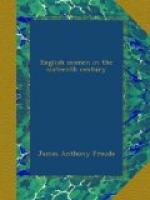Elizabeth approved. Hawkins had opened the road to the West Indies. He had shown how easy slave smuggling was, and how profitable it was: how it was also possible for the English to establish friendly relations with the Spanish settlers in the West Indies, whether Philip liked it or not. Another company was formed for a second trial. Elizabeth took shares, Lord Pembroke took shares, and other members of the Council. The Queen lent the Jesus, a large ship of her own, of 700 tons. Formal instructions were given that no wrong was to be done to the King of Spain, but what wrong might mean was left to the discretion of the commander. Where the planters were all eager to purchase, means of traffic would be discovered without collision with the authorities. This time the expedition was to be on a larger scale, and a hundred soldiers were put on board to provide for contingencies. Thus furnished, Hawkins started on his second voyage in October 1564. The autumn was chosen, to avoid the extreme tropical heats. He touched as before to see his friends at the Canaries. He went on to the Rio Grande, met with adventures bad and good, found a chief at war with a neighbouring tribe, helped to capture a town and take prisoners, made purchases at a Portuguese factory. In this way he now secured 400 human cattle, perhaps for a better fate than they would have met with at home, and with these he sailed off in the old direction. Near the equator he fell in with calms; he was short of water, and feared to lose some of them; but, as the record of the voyage puts it, ’Almighty God would not suffer His elect to perish,’ and sent a breeze which carried him safe to Dominica. In that wettest of islands he found water in plenty, and had then to consider what next he would do. St. Domingo, he thought, would be no longer safe for him; so he struck across to the Spanish Main to a place called Burboroata, where he might hope that nothing would be known about him. In this he was mistaken. Philip’s orders had arrived: no Englishman of any creed or kind was to be allowed to trade in his West India dominions. The settlers, however, intended to trade. They required only a display of force that they might pretend that they were yielding to compulsion. Hawkins told his old story. He said that he was out on the service of the Queen of England. He had been driven off his course by bad weather. He was short of supplies and had many men on board, who might do the town some mischief if they were not allowed to land peaceably and buy and sell what they wanted. The Governor affecting to hesitate, he threw 120 men on shore, and brought his guns to bear on the castle. The Governor gave way under protest. Hawkins was to be permitted to sell half his negroes. He said that as he had been treated so inhospitably he would not pay the 30 per cent. The King of Spain should have 7 1/2, and no more. The settlers had no objection. The price would be the less, and with this deduction his business was easily finished off. He bought no more hides, and was paid in solid silver.




